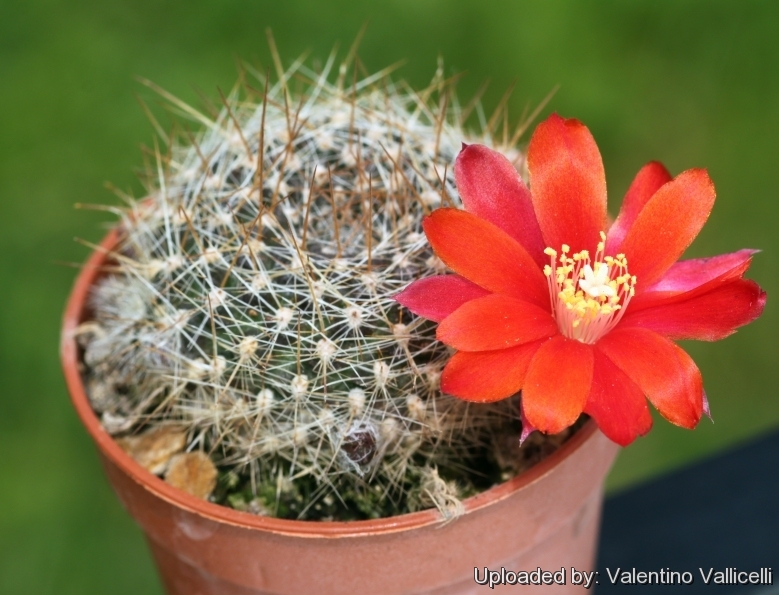Accepted Scientific Name: Rebutia pseudodeminuta Backeb.
Kakteenkunde ii. No. 1 (1933); Backeb. Blatter Kakteenforsch. 1934, Pt. 8,[p. 2].

Rebutia sanguiniflora Photo by: Valentino Vallicelli
Origin and Habitat: Tarija, Tarija, Bolivia.
Field number: WR492.
Synonyms:
See all synonyms of Rebutia pseudodeminuta
Description: Rebutia sanguinifloraSN|5033]]SN|31126]] is an undescribed name used in some seed catalog to indicate one of the innumerable local form of the variable Rebutia pseudodeminutaSN|4970]]SN|4970]] with showy blood-red flowers, but others forms are similar and plants from other localities look more like it. It is sometimes synonyzed with Rebutia spegazzinianaSN|31126]]SN|5033]].
Subspecies, varieties, forms and cultivars of plants belonging to the Rebutia deminuta group
Cultivation and Propagation: Rebutia sanguinifloraSN|31126]]SN|31126]] is a summer grower species that is easy to cultivate.
Growth rate: It is a relatively rapidly growing and easily flowering species that will make clumps given the best conditions.
Soils: It likes very porous standard cactus mix soil. Prefer a neutral or low pH compost, avoid substrata rich in limestone.
Repotting: It is better that they are repotted regularly. Repotting will increase the number and size of stems and will increase the number of flowers produced. Repot yearly until reaching about 100mm in size, then every two or three years will suffice. Repotting is best done at the end of winter but can be done at other times. Do not water for a couple of weeks after repotting to reduce risk of root rot via broken roots. Use pot with good drainage.
Watering: Needs moderate to copious waterings in summer, but do not overwater (Rot prone), keep dry in winter at a minimum temperature of 0°C.
Fertilization: Feed with a high potassium fertilizer in summer.
Hardiness: Reputedly resistant to frost if kept on the dry side prior to, and during, cold weather (hardy to -4 C ° C, or less for short periods).
Exposition: The plant tolerates bright situations but enjoys filtered sunlight or afternoon shade, inside it needs bright light, and some direct sun. Tends to bronze in strong light, which encourages flowering and heavy spine production, but is likely to suffer from sun scorch or stunted growth if over exposed to direct sunlight during the hottest part of the day in summer.
Uses: It is an excellent plant for container growing. It always looks good and stays small. It look fine in a cold greenhouse and frame or outdoor in a rockery.
Pests & diseases: It may be attractive to a variety of insects, but plants in good condition should be nearly pest-free, particularly if they are grown in a mineral potting-mix, with good exposure and ventilation. Nonetheless, there are several pests to watch for:
- Red spiders: Red spiders may be effectively rubbed up by watering the plants from above.
- Mealy bugs: Mealy bugs occasionally develop aerial into the new growth among the wool with disfiguring results, but the worst types develop underground on the roots and are invisible except by their effects.
- Scales: Scales are rarely a problem.
- Rot: This species is particularly easy and accommodating, seldom suffer of cryptogamic diseases. Rot it is only a minor problem with rebutias if the plants are watered and “aired” correctly. If they are not, fungicides won't help all that much.
Propagation: Division, direct sow after last frost. Seeds germinate in 7-14 days at 21-27° C in spring, remove gradually the glass cover as soon the plants will be well rooted (ca 1-2 weeks) and keep ventilated, no full sun for young plants! Seed Collecting: Permit fruit to ripen. Fruit must be significantly overripe before harvesting seed; clean and dry seeds. To make a cutting twist off a branch and permit it to dry out a couple of weeks, lay it on the soil and insert the stem end partially into the soil. Try to keep the cutting somewhat upright so that the roots are able to grow downward.











